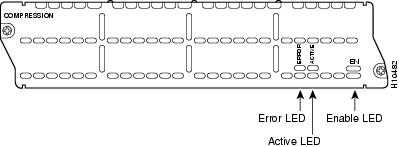Compression Network Modules
Available Languages
Table Of Contents
Connecting Cisco Compression Network Modules to the Network
Compression Network Module LEDs
Obtaining Documentation, Obtaining Support, and Security Guidelines
Connecting Cisco Compression Network Modules to the Network
Revised: May 1, 2008, OL-12818-01
This guide describes how to connect Cisco compression network modules to your network. It contains the following sections:
•
Compression Network Module LEDs
•
Obtaining Documentation, Obtaining Support, and Security Guidelines
Compression Network Modules
The compression network module (NM-COMPR) does not provide network interfaces of its own, but instead compresses and decompresses data passing through interfaces on other network modules or WAN interface cards in the router. (See Figure 1.)
Hardware compression is supported only over Point-to-Point Protocol (PPP) links. The compression network module supports only the Stacker compression algorithm.
Cisco IOS Release 11.3 and later releases allow Frame Relay compression support using the FRF.9 compression algorithm.
Figure 1 Compression Network Module

Interfaces Supported
The compression network module supports the following interfaces:
•
Channelized T1 Integrated Services Digital Network (ISDN) Primary Rate Interface (PRI)
•
Channelized E1 ISDN PRI
•
ISDN Basic Rate Interface (BRI)
•
Synchronous serial
•
Switched 56-kbps data service unit/channel service unit (DSU/CSU)
Compression Network Module LEDs
Figure 2 shows compression network module LEDs. Table 1 describes their meaning.
Figure 2 Compression Network Module LEDs

Related Documents
For additional information, see the following documents and resources.
Regulatory compliance and safety information
Cisco Network Modules and Interface Cards Regulatory Compliance and Safety Information
http://www.cisco.com/en/US/docs/routers/access/interfaces/rcsi/IOHrcsi.htmlCisco IOS software website and reference documentation
Cisco IOS Software http://www.cisco.com/web/psa/products/index.html?c=268438303
Obtaining Documentation, Obtaining Support, and Security Guidelines
For information on obtaining documentation, obtaining support, providing documentation feedback, security guidelines, and also recommended aliases and general Cisco documents, see the monthly What's New in Cisco Product Documentation, which also lists all new and revised Cisco technical documentation, at:
http://www.cisco.com/en/US/docs/general/whatsnew/whatsnew.html
CCDE, CCENT, Cisco Eos, Cisco Lumin, Cisco StadiumVision, the Cisco logo, DCE, and Welcome to the Human Network are trademarks; Changing the Way We Work, Live, Play, and Learn is a service mark; and Access Registrar, Aironet, AsyncOS, Bringing the Meeting To You, Catalyst, CCDA, CCDP, CCIE, CCIP, CCNA, CCNP, CCSP, CCVP, Cisco, the Cisco Certified Internetwork Expert logo, Cisco IOS, Cisco Press, Cisco Systems, Cisco Systems Capital, the Cisco Systems logo, Cisco Unity, Collaboration Without Limitation, EtherFast, EtherSwitch, Event Center, Fast Step, Follow Me Browsing, FormShare, GigaDrive, HomeLink, Internet Quotient, IOS, iPhone, iQ Expertise, the iQ logo, iQ Net Readiness Scorecard, iQuick Study, IronPort, the IronPort logo, LightStream, Linksys, MediaTone, MeetingPlace, MGX, Networkers, Networking Academy, Network Registrar, PCNow, PIX, PowerPanels, ProConnect, ScriptShare, SenderBase, SMARTnet, Spectrum Expert, StackWise, The Fastest Way to Increase Your Internet Quotient, TransPath, WebEx, and the WebEx logo are registered trademarks of Cisco Systems, Inc. and/or its affiliates in the United States and certain other countries.
All other trademarks mentioned in this document or Website are the property of their respective owners. The use of the word partner does not imply a partnership relationship between Cisco and any other company. (0804R)
Any Internet Protocol (IP) addresses used in this document are not intended to be actual addresses. Any examples, command display output, and figures included in the document are shown for illustrative purposes only. Any use of actual IP addresses in illustrative content is unintentional and coincidental.
© 2008 Cisco Systems, Inc. All rights reserved.
Contact Cisco
- Open a Support Case

- (Requires a Cisco Service Contract)
 Feedback
Feedback